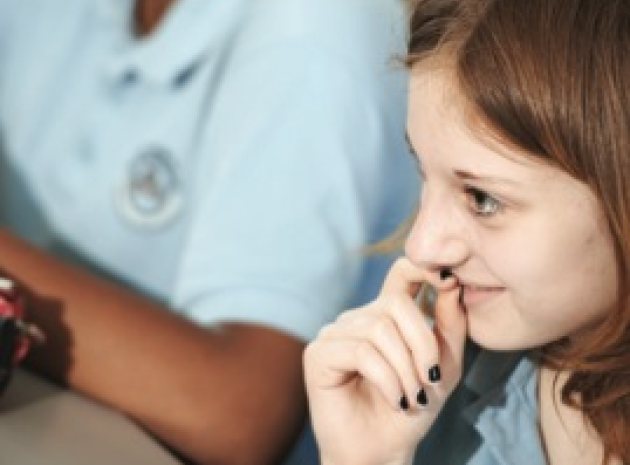PLENTY OF LOLLY
Connecting the result from a probability experiment to a theoretical explanation for it is an excellent way of developing learners’ understanding of chance, says Colin Foster
Young people often enjoy doing probability experiments, but sometimes the results are just taken as empirical facts without any explanation. In this lesson, learners carry out an experiment and then try to explain their results theoretically.
STARTER ACTIVITY
Q: I have a container of lolly sticks here. Each lolly stick has one of your names on it and there is one lolly stick for every learner in the room. I am going to choose who is going to answer each question in today’s lesson by picking a lolly stick out of the cup. Here is the first question: When I pick out a lolly stick and someone answers a question, do you think I should put the stick back in the cup or not? Why?
It may be that you already have this or a similar system operating in your classroom, or you might just be using it for today’s lesson. This question gives learners the opportunity to think about the purpose of such a system. You could use the lolly sticks to ask three or four learners for their opinions.
If you don’t put the lolly sticks back, then the order in which the learners are chosen is random, but who is going to be next is increasingly predictable as the number of sticks left in the cup decreases. So the element of surprise diminishes as you go on. Eventually you will run out of sticks and have to put them all back in. On the other hand, if you put the sticks back as you go, there is complete uncertainty over who will be asked each question, but you could end up picking the same person many times and missing out someone else altogether
Q: In this lesson, I am going to put the sticks back in the container each time. How many questions do you think I would need to ask before everyone has answered at least one question? Talk about it with the person next to you.
This is quite a complicated question, so it may take your KS3 pupils a few minutes to work out what you are asking. They may initially think it is just the same as the number of people in the class, but that would be the right answer if the sticks did not go back in the container. Given that they do, that number is almost certainly too low, unless the teacher is very lucky. Learners might realise that, in principle, it could take infinitely long, because, although it is unlikely, a certain learner’s lolly stick might never be picked!
You could use the lolly sticks to ask three or four more people what they think about this, and to describe what they discussed in pairs, before the main activities below.
MAIN ACTIVITIES
1. Experiment
Q: How could we work out how many questions are needed before everyone has answered at least one?
There may be all sorts of theoretical arguments given, but eventually someone will suggest ‘Try it!’, and you could ask learners to describe exactly how they will carry out the experiment. They could work in pairs and have a class list to tick off against each name when they pull out the appropriate lolly stick. However, it might be more sensible to begin with fewer lolly sticks - maybe just 3 or 4 to start with. If learners can establish a pattern and understand what is going on, maybe they won’t have to simulate with the whole class, which would take a long time.
Different groups of learners could try different ‘class sizes’ and collect their results into a table on the board. They could try their ‘class size’ several times and find the mean of their results.
The theoretical answers (correct to 1 decimal place) are given in the table below, but learners’ results might well be quite different from these:
Learners may be surprised at how many questions are needed – for a class of 30 learners, four times that many questions are required!
2. Theory
Q: What did you find out? Were you surprised? Why? Can you think of a way of calculating these numbers exactly, without having to do experiments?
This is hard. One way to think about it is to start with small classes. For a class of 1 learner, it should be obvious that they will have to answer the first question! With 2 learners it is not quite so easy to see that the answer is 3, not 2. One of the 2 learners will have to answer the first question, but then they each have a 50% chance of being asked the second question, so on average it will take two more questions before both of them have answered at least one question.
If learners don’t believe this answer, they should try throwing an ordinary coin until both heads and tails have turned up at least once. An ordinary coin is equivalent to a class size of 2, and on average it will take 3 throws.
An ordinary die is equivalent to a class size of 6. On the first throw, you are guaranteed to get a number that you haven’t had yet.
Then you are throwing to get one of the 5 remaining numbers that you haven’t had yet, with a probability of 5/6 each time, so on average it will take you 6/5 throws before that happens. Then you have to throw for the third number that you haven’t had yet, with probability 4/6 each throw, and so on average it will take you 6/4 throws to get that one, and so on.
So the total number of throws needed to get all 6 numbers at least once will be 1 + 6/5 + 6/4 + 6/3 + 6/2 + 6/1 = 14.7 exactly (not rounded). (You can think of the 1 at the start as 6/6 to complete the pattern.)
Learners could try to explain this reasoning to one another, but it is difficult to get!
HOME LEARNING
Learners could estimate the number of questions that the teacher typically asks per lesson, so as to convert their answer into an average number of lessons (or days/weeks) that they might have to wait before being asked a question. Maybe they have different suggestions for systems of classroom question asking?
+ JOIN THE MA
According to Peter Ransom, President of The Mathematical Association, “Teaching mathematics is the most satisfying job in the world. Every day I’ve spent in the classroom I’ve had a buzz as I entered the school gates and it’s a joy to work with such a variety of young people. September brings its own special enjoyment with new faces in staff and students and the anticipation of things to come.
Working with The Mathematical Association is extremely satisfying, especially with the abundance of consultation documents of late!” Join the MA at www.m-a.org.uk.
SUMMARY
You could conclude the lesson with a plenary in which learners talk about what they have learned about probability. They may have noticed that it takes very little time to get questions to the first few different learners but much longer to reach the last few. Depending on how many learners you have in your class, they might have found that it will take over 100 questions on average before they have all had the opportunity to answer one.
For a huge selection of free maths lesson plans for KS3 and KS4 click here.









